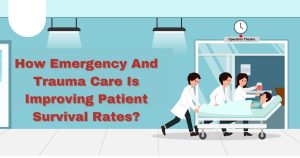 The speed of modern life is what has increased the need for quality emergency trauma care the most. Medical emergencies can strike at any time. Timely intervention can mean the difference between life and death. High-tech healthcare and specialized hospital teams are changing emergency and trauma services. It is improving patient survival rates. The most recent advancements in emergency and trauma care are discussed.
The speed of modern life is what has increased the need for quality emergency trauma care the most. Medical emergencies can strike at any time. Timely intervention can mean the difference between life and death. High-tech healthcare and specialized hospital teams are changing emergency and trauma services. It is improving patient survival rates. The most recent advancements in emergency and trauma care are discussed.
Role Of Emergency and Trauma Care In-Patient Outcome
Emergency and trauma care involves assessing, diagnosing, and treating life-threatening injuries or conditions that need urgent medical attention. Trauma care refers to extreme physical injuries from accidents, falls, or violence. Emergency and trauma services are aimed not only at saving lives but also at preventing complications and improving recovery in patients with severe injuries.
Key Advances In Emergency Trauma Services
1.Faster Response Times Through Integrated Systems.
The speed of response is one of the most important features in trauma care. Here, the clock ticks differently. It starts right after a patient enters an emergency department, and the counting of seconds becomes of greater importance. Many U.S. hospitals have a system for quick, streamlined triage. Here, patients are judged accordingly to get the critical care cases done immediately.
2.Quick Assessment Diagnostic Equipment
A swift and exact diagnosis has always been the foundational principle of successful treatment of any trauma. This made top hospitals invest in modern diagnostic equipment. They bought portable CT scanners, ultrasound devices, and X-ray machines. With such equipment, a medical team can assess what kind of injury a person has in the shortest amount of time. This could then aid a medical professional in making an informed choice about what form of treatment is to be administered to a patient.
For instance, at the top hospital in Ahmedabad, diagnostic tools are part of the emergency care pathway, which allows specialists to make quick and informed decisions. These improvements cut the time to find and treat critical injuries. This is key to improving patient survival rates.
3.Skilled And Specialized Medical Teams
Emergency and trauma treatment is multidisciplinary, and it demands multidisciplinary experts. Leading hospitals usually have specialized units, like surgical and orthopedic ones, in neurology and cardiology. Experts handle high-complexity injuries. They have the skills to meet each case’s needs.
4.Adoption Of New Technologies of Advanced Life Saving
The cornerstone of modern emergency trauma care is the latest available technology. Portable ventilators, defibrillators, and ECMO machines are vital. They support patients during transit or on arrival. Robotic surgery and minimally invasive techniques help trauma surgeons. They can now perform complex procedures more precisely, avoiding complications.
Innovative technology is used for the upliftment of patient care at the top hospital in Ahmedabad. They help the trauma team stabilize critical patients quickly. This ensures effective treatment and the best chance of survival for severe injury victims.
5.Effective Trauma Care Protocols And Procedures
The use of standardized protocols in trauma care has very effectively reduced mortality rates. The hospitals use evidence-based guidelines in this regard. They follow the Advanced Trauma Life Support system to standardize the initial assessment and management of trauma patients. This ensures the right interventions reach each patient quickly. It’s the only option in life-threatening situations.
How Emergency And Trauma Care Centers Raise The Bar
1.Advanced Emergency Facilities
High-volume emergency trauma centers house the top patients in hospitals. They are for the smooth flow of patients. Specific facilities are trauma units, operating rooms, and recovery areas. They have the latest tech to treat critical cases.
2.Psychological And Post-Trauma Support
Recovery from a traumatic event is usually only the first step of a long journey. Heads of emergency and trauma services care for patients not only on a physical level but also offer psychological and rehabilitative care. This holistic approach speeds recovery and improves mental health. Both are vital for a full recovery.
3.Community Outreach And Preventive Programs
Hospitals have been very aggressive about trauma care lately. They are educating the community as to how to prevent injury and the proper first response to a case. The outreach is raising awareness of injuries, safe driving, and ways to reduce accidents.
By conducting these programs, hospitals will reduce the cases of preventable injuries. The emergency trauma center will hence not have increased pressure in cases.
Efforts to channel severe cases
Emergency And Trauma Care: The Future
The area of emergency trauma care is constantly changing with the advancement of medical science and technology. Other promising ideas include telemedicine, AI diagnostics, and health monitors via wearables. They can diagnose faster, monitor patients in real-time, and intervene early to boost survival rates.
Conclusion
Trauma care has improved survival and quality of care in many top hospitals, especially in Ahmedabad. 1 hospital, is because of the trend of rising emergency trauma care. Emergency trauma care is revolutionized by the latest diagnostic equipment, skilled teams in handling trauma care, highly developed life-saving technology, and efficient trauma care protocol under which hospitals change their very approach to critical injury or emergencies.
